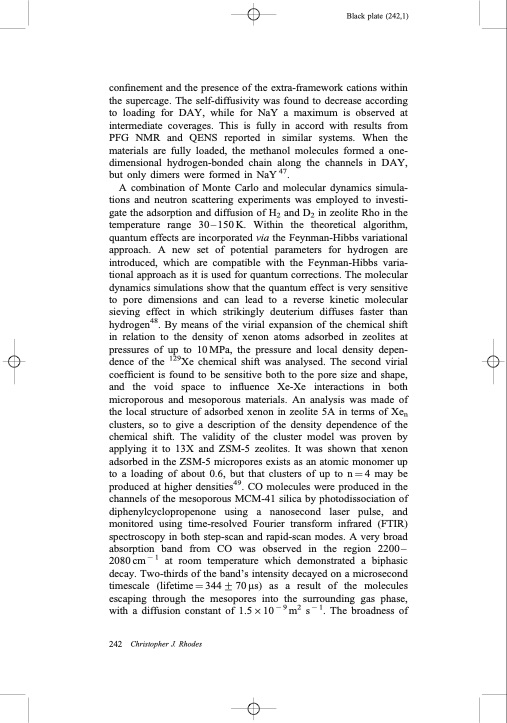
PDF Publication Title:
Text from PDF Page: 020
Black plate (242,1) confinement and the presence of the extra-framework cations within the supercage. The self-diffusivity was found to decrease according to loading for DAY, while for NaY a maximum is observed at intermediate coverages. This is fully in accord with results from PFG NMR and QENS reported in similar systems. When the materials are fully loaded, the methanol molecules formed a one- dimensional hydrogen-bonded chain along the channels in DAY, but only dimers were formed in NaY47. A combination of Monte Carlo and molecular dynamics simula- tions and neutron scattering experiments was employed to investi- gate the adsorption and diffusion of H2 and D2 in zeolite Rho in the temperature range 30 – 150 K. Within the theoretical algorithm, quantum effects are incorporated via the Feynman-Hibbs variational approach. A new set of potential parameters for hydrogen are introduced, which are compatible with the Feynman-Hibbs varia- tional approach as it is used for quantum corrections. The molecular dynamics simulations show that the quantum effect is very sensitive to pore dimensions and can lead to a reverse kinetic molecular sieving effect in which strikingly deuterium diffuses faster than hydrogen48. By means of the virial expansion of the chemical shift in relation to the density of xenon atoms adsorbed in zeolites at pressures of up to 10MPa, the pressure and local density depen- dence of the 129Xe chemical shift was analysed. The second virial coefficient is found to be sensitive both to the pore size and shape, and the void space to influence Xe-Xe interactions in both microporous and mesoporous materials. An analysis was made of the local structure of adsorbed xenon in zeolite 5A in terms of Xen clusters, so to give a description of the density dependence of the chemical shift. The validity of the cluster model was proven by applying it to 13X and ZSM-5 zeolites. It was shown that xenon adsorbed in the ZSM-5 micropores exists as an atomic monomer up to a loading of about 0.6, but that clusters of up to n1⁄44 may be produced at higher densities49. CO molecules were produced in the channels of the mesoporous MCM-41 silica by photodissociation of diphenylcyclopropenone using a nanosecond laser pulse, and monitored using time-resolved Fourier transform infrared (FTIR) spectroscopy in both step-scan and rapid-scan modes. A very broad absorption band from CO was observed in the region 2200– 2080 cm 1 at room temperature which demonstrated a biphasic decay. Two-thirds of the band’s intensity decayed on a microsecond timescale (lifetime 1⁄4 344 + 70 ms) as a result of the molecules escaping through the mesopores into the surrounding gas phase, with a diffusion constant of 1.5610 9 m2 s 1. The broadness of 242 Christopher J. RhodesPDF Image | Properties and applications of zeolites

PDF Search Title:
Properties and applications of zeolitesOriginal File Name Searched:
003685010x12800828155007.pdfDIY PDF Search: Google It | Yahoo | Bing
CO2 Organic Rankine Cycle Experimenter Platform The supercritical CO2 phase change system is both a heat pump and organic rankine cycle which can be used for those purposes and as a supercritical extractor for advanced subcritical and supercritical extraction technology. Uses include producing nanoparticles, precious metal CO2 extraction, lithium battery recycling, and other applications... More Info
Heat Pumps CO2 ORC Heat Pump System Platform More Info
| CONTACT TEL: 608-238-6001 Email: greg@infinityturbine.com | RSS | AMP |